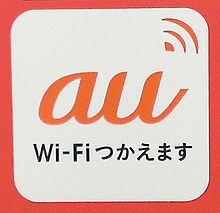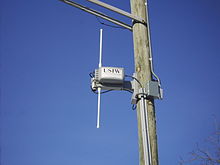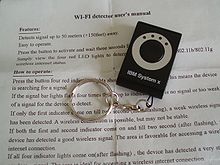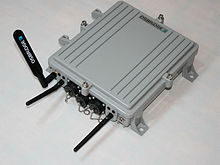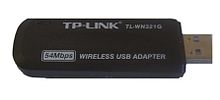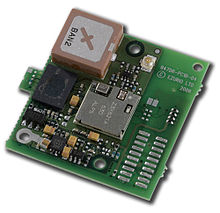
Wi-Fi
Did you know...
SOS Children made this Wikipedia selection alongside other schools resources. Click here for more information on SOS Children.
Wi-Fi (also spelled Wifi or WiFi) is a popular technology that allows an electronic device to exchange data wirelessly (using radio waves) over a computer network, including high-speed Internet connections. The Wi-Fi Alliance defines Wi-Fi as any " wireless local area network (WLAN) products that are based on the Institute of Electrical and Electronics Engineers' (IEEE) 802.11 standards". However, since most modern WLANs are based on these standards, the term "Wi-Fi" is used in general English as a synonym for "WLAN". Only Wi-Fi products that complete Wi-Fi Alliance interoperability certification testing successfully may use the "Wi-Fi CERTIFIED" trademark.
A device that can use Wi-Fi (such as a personal computer, video-game console, smartphone, tablet, or digital audio player) can connect to a network resource such as the Internet via a wireless network access point. Such an access point (or hotspot) has a range of about 20 meters (65 feet) indoors and a greater range outdoors. Hotspot coverage can comprise an area as small as a single room with walls that block radio waves or as large as many square miles — this is achieved by using multiple overlapping access points.
Wi-Fi can be less secure than wired connections (such as Ethernet) because an intruder does not need a physical connection. Web pages that use SSL are secure but unencrypted internet access can easily be detected by intruders. Because of this, Wi-Fi has adopted various encryption technologies. The early encryption WEP, proved easy to break. Higher quality protocols ( WPA, WPA2) were added later. An optional feature added in 2007, called Wi-Fi Protected Setup (WPS), had a serious flaw that allowed an attacker to recover the router's password. The Wi-Fi Alliance has since updated its test plan and certification program to ensure all newly certified devices resist attacks. The use of WPS greatly reduces the time required to gain access by the use of so called "brute force" attacks.
History
802.11 technology has its origins in a 1985 ruling by the US Federal Communications Commission that released the ISM band for unlicensed use. In 1991, NCR Corporation with AT&T Corporation invented the precursor to 802.11 intended for use in cashier systems. The first wireless products were under the name WaveLAN.
Vic Hayes has been called the "father of Wi-Fi" by some, due to his involvement in negotiating the initial standards within the IEEE while chairing the workgroup.
A large number of patents by many companies are used in 802.11 standard. In 1992 and 1996, Australian organization CSIRO obtained patents for a method later used in Wi-Fi to "unsmear" the signal. In April 2009, 14 tech companies agreed to pay CSIRO $250 million for infringements on CSIRO patents. This led to Wi-Fi being attributed as an Australian invention, though this has been the subject of some controversy. CSIRO won a further $220 million settlement for Wi-Fi patent infringements in 2012 with global firms in the United States required to pay the CSIRO licensing rights estimated to be worth an additional $1 billion in royalties.
In 1999, the Wi-Fi Alliance was formed as a trade association to hold the Wi-Fi trademark under which most products are sold.
The key technologies behind Wi-Fi were developed by the radioastronomer John O'Sullivan as a by-product in a research project, "a failed experiment to detect exploding mini black holes the size of an atomic particle".
The name
The term Wi-Fi, first used commercially in August 1999, was coined by a brand-consulting firm called Interbrand Corporation. The Wi-Fi Alliance had hired Interbrand to determine a name that was "a little catchier than 'IEEE 802.11b Direct Sequence'". Belanger also stated that Interbrand invented Wi-Fi as a play on words with Hi-Fi (high fidelity), and also created the Wi-Fi logo.
The Wi-Fi Alliance initially used the advertising slogan, "The Standard for Wireless Fidelity", for Wi-Fi but later removed the phrase from their marketing. Despite this, some documents from the Alliance dated 2003 and 2004 still contain the term Wireless Fidelity. There was no official statement related to the dropping of the term.
The yin-yang Wi-Fi logo indicates the certification of a product for interoperability.
Non-Wi-Fi technologies intended for fixed points such as Motorola Canopy are usually described as fixed wireless. Alternative wireless technologies include mobile phone standards such as 2G, 3G or 4G.
Wi-Fi certification
The IEEE does not test equipment for compliance with their standards. The non-profit Wi-Fi Alliance was formed in 1999 to fill this void — to establish and enforce standards for interoperability and backward compatibility, and to promote wireless local-area-network technology. As of 2010, the Wi-Fi Alliance consisted of more than 375 companies from around the world. The Wi-Fi Alliance enforces the use of the Wi-Fi brand to technologies based on the IEEE 802.11 standards from the Institute of Electrical and Electronics Engineers. This includes wireless local area network (WLAN) connections, device to device connectivity (such as Wi-Fi Peer to Peer aka Wi-Fi Direct), Personal area network (PAN), local area network (LAN) and even some limited wide area network (WAN) connections. Manufacturers with membership in the Wi-Fi Alliance, whose products pass the certification process, gain the right to mark those products with the Wi-Fi logo.
Specifically, the certification process requires conformance to the IEEE 802.11 radio standards, the WPA and WPA2 security standards, and the EAP authentication standard. Certification may optionally include tests of IEEE 802.11 draft standards, interaction with cellular-phone technology in converged devices, and features relating to security set-up, multimedia, and power-saving.
Not every Wi-Fi device is submitted for certification. The lack of Wi-Fi certification does not necessarily imply that a device is incompatible with other Wi-Fi devices. If it is compliant or partly compatible, the Wi-Fi Alliance may not object to its description as a Wi-Fi device though technically only certified devices are approved. Derivative terms, such as Super Wi-Fi, coined by the US Federal Communications Commission (FCC) to describe proposed networking in the UHF TV band in the US, may or may not be sanctioned.
Uses
To connect to a Wi-Fi LAN, a computer has to be equipped with a wireless network interface controller. The combination of computer and interface controller is called a station. All stations share a single radio frequency communication channel. Transmissions on this channel are received by all stations within range. The hardware does not signal the user that the transmission was delivered and is therefore called a best-effort delivery mechanism. A carrier wave is used to transmit the data in packets, referred to as " Ethernet frames". Each station is constantly tuned in on the radio frequency communication channel to pick up available transmissions.
Internet access
A Wi-Fi-enabled device can connect to the Internet when within range of a wireless network. The coverage of one or more (interconnected) access points — called hotspots — can extend from an area as small as a few rooms to as large as many square miles. Coverage in the larger area may require a group of access points with overlapping coverage. Outdoor public Wi-Fi technology has been used successfully in wireless mesh networks in London, UK.
Wi-Fi provides service in private homes, high street chains and independent businesses, as well as in public spaces at Wi-Fi hotspots set up either free-of-charge or commercially. Organizations and businesses, such as airports, hotels, and restaurants, often provide free-use hotspots to attract customers. Enthusiasts or authorities who wish to provide services or even to promote business in selected areas sometimes provide free Wi-Fi access.
Routers that incorporate a digital subscriber line modem or a cable modem and a Wi-Fi access point, often set up in homes and other buildings, provide Internet access and internetworking to all devices connected to them, wirelessly or via cable.
Similarly, there are battery-powered routers that include a cellular mobile Internet radiomodem and Wi-Fi access point. When subscribed to a cellular phone carrier, they allow nearby Wi-Fi stations to access the Internet over 2G, 3G, or 4G networks. Many smartphones have a built-in capability of this sort, including those based on Android, Bada, iOS ( iPhone), Windows Phone and Symbian, though carriers often disable the feature, or charge a separate fee to enable it, especially for customers with unlimited data plans. "Internet pucks" provide standalone facilities of this type as well, without use of a smartphone; examples include the MiFi- and WiBro-branded devices. Some laptops that have a cellular modem card can also act as mobile Internet Wi-Fi access points.
Wi-Fi also connects places that normally don't have network access, such as kitchens and garden sheds.
City-wide Wi-Fi
In the early 2000s, many cities around the world announced plans to construct city-wide Wi-Fi networks. There are many successful examples; in 2004, Mysore became India's first Wi-Fi-enabled city and second in the world after Jerusalem. A company called WiFiyNet has set up hotspots in Mysore, covering the complete city and a few nearby villages.
In 2005, Sunnyvale, California, became the first city in the United States to offer city-wide free Wi-Fi, and Minneapolis has generated $1.2 million in profit annually for its provider.
In May 2010, London, UK, Mayor Boris Johnson pledged to have London-wide Wi-Fi by 2012. Several boroughs including Westminster and Islington already have extensive outdoor Wi-Fi coverage.
Officials in South Korea's capital are moving to provide free Internet access at more than 10,000 locations around the city, including outdoor public spaces, major streets and densely populated residential areas. Seoul will grant leases to KT, LG Telecom and SK Telecom. The companies will invest $44 million in the project, which will be completed in 2015.
Campus-wide Wi-Fi
Many traditional college campuses in the United States provide at least partial wireless Wi-Fi Internet coverage. Carnegie Mellon University built the first campus-wide wireless Internet network, called Wireless Andrew, at its Pittsburgh campus in 1993 before Wi-Fi branding originated. In Europe many universities collaborate in providing Wi-Fi access to students and staff through the eduroam international authentication infrastructure.
In 2000, Drexel University in Philadelphia became the United States's first major university to offer completely wireless Internet access across its entire campus.
The Far Eastern University in Manila is the first university in the Philippines to implement a campus-wide Wi-Fi coverage for its students, faculty, and staff.
Direct computer-to-computer communications
Wi-Fi also allows communications directly from one computer to another without an access point intermediary. This is called ad hoc Wi-Fi transmission. This wireless ad hoc network mode has proven popular with multiplayer handheld game consoles, such as the Nintendo DS, PlayStation Portable, digital cameras, and other consumer electronics devices. Some devices can also share their Internet connection using ad-hoc, becoming hotspots or "virtual routers".
Similarly, the Wi-Fi Alliance promotes a specification called Wi-Fi Direct for file transfers and media sharing through a new discovery- and security-methodology. Wi-Fi Direct launched in October 2010.
Advantages and limitations
Advantages
Wi-Fi allows cheaper deployment of local area networks (LANs). Also spaces where cables cannot be run, such as outdoor areas and historical buildings, can host wireless LANs.
Manufacturers are building wireless network adapters into most laptops. The price of chipsets for Wi-Fi continues to drop, making it an economical networking option included in even more devices.
Different competitive brands of access points and client network-interfaces can inter-operate at a basic level of service. Products designated as "Wi-Fi Certified" by the Wi-Fi Alliance are backwards compatible. Unlike mobile phones, any standard Wi-Fi device will work anywhere in the world.
Wi-Fi Protected Access encryption (WPA2) is considered secure, provided a strong passphrase is used. New protocols for quality-of-service ( WMM) make Wi-Fi more suitable for latency-sensitive applications (such as voice and video). Power saving mechanisms (WMM Power Save) extend battery life.
Limitations
Spectrum assignments and operational limitations are not consistent worldwide: most of Europe allows for an additional two channels beyond those permitted in the US for the 2.4 GHz band (1–13 vs. 1–11), while Japan has one more on top of that (1–14). As of 2007, Europe is essentially homogeneous in this respect.
A Wi-Fi signal occupies five channels in the 2.4 GHz band. Any two channel numbers that differ by five or more, such as 2 and 7, do not overlap. The oft-repeated adage that channels 1, 6, and 11 are the only non-overlapping channels is, therefore, not accurate. Channels 1, 6, and 11 are the only group of three non-overlapping channels in the U.S. In Europe and Japan using Channels 1, 5, 9, and 13 for 802.11g and n is recommended.
Equivalent isotropically radiated power (EIRP) in the EU is limited to 20 dBm (100 mW).
The current 'fastest' norm, 802.11n, uses double the radio spectrum/bandwidth (40 MHz) compared to 802.11a or 802.11g (20 MHz). This means there can be only one 802.11n network on the 2.4 GHz band at a given location, without interference to/from other WLAN traffic. 802.11n can also be set to use 20 MHz bandwidth only to prevent interference in dense community.
Range
Wi-Fi networks have limited range. A typical wireless access point using 802.11b or 802.11g with a stock antenna might have a range of 32 m (120 ft) indoors and 95 m (300 ft) outdoors. IEEE 802.11n, however, can more than double the range. Range also varies with frequency band. Wi-Fi in the 2.4 GHz frequency block has slightly better range than Wi-Fi in the 5 GHz frequency block which is used by 802.11a and optionally by 802.11n. On wireless routers with detachable antennas, it is possible to improve range by fitting upgraded antennas which have higher gain in particular directions. Outdoor ranges can be improved to many kilometers through the use of high gain directional antennas at the router and remote device(s). In general, the maximum amount of power that a Wi-Fi device can transmit is limited by local regulations, such as FCC Part 15 in the US.
Due to reach requirements for wireless LAN applications, Wi-Fi has fairly high power consumption compared to some other standards. Technologies such as Bluetooth (designed to support wireless PAN applications) provide a much shorter propagation range of <10m and so in general have a lower power consumption. Other low-power technologies such as ZigBee have fairly long range, but much lower data rate. The high power consumption of Wi-Fi makes battery life in mobile devices a concern.
Researchers have developed a number of "no new wires" technologies to provide alternatives to Wi-Fi for applications in which Wi-Fi's indoor range is not adequate and where installing new wires (such as CAT-5) is not possible or cost-effective. For example, the ITU-T G.hn standard for high speed Local area networks uses existing home wiring ( coaxial cables, phone lines and power lines). Although G.hn does not provide some of the advantages of Wi-Fi (such as mobility or outdoor use), it's designed for applications (such as IPTV distribution) where indoor range is more important than mobility.
Due to the complex nature of radio propagation at typical Wi-Fi frequencies, particularly the effects of signal reflection off trees and buildings, algorithms can only approximately predict Wi-Fi signal strength for any given area in relation to a transmitter. This effect does not apply equally to long-range Wi-Fi, since longer links typically operate from towers that transmit above the surrounding foliage.
The practical range of Wi-Fi essentially confines mobile use to such applications as inventory-taking machines in warehouses or in retail spaces, barcode-reading devices at check-out stands, or receiving/shipping stations. Mobile use of Wi-Fi over wider ranges is limited, for instance, to uses such as in an automobile moving from one hotspot to another. Other wireless technologies are more suitable for communicating with moving vehicles.
Data security risks
The most common wireless encryption-standard, Wired Equivalent Privacy (WEP), has been shown to be easily breakable even when correctly configured. Wi-Fi Protected Access (WPA and WPA2) encryption, which became available in devices in 2003, aimed to solve this problem. Wi-Fi access points typically default to an encryption-free (open) mode. Novice users benefit from a zero-configuration device that works out-of-the-box, but this default does not enable any wireless security, providing open wireless access to a LAN. To turn security on requires the user to configure the device, usually via a software graphical user interface (GUI). On unencrypted Wi-Fi networks connecting devices can monitor and record data (including personal information). Such networks can only be secured by using other means of protection, such as a VPN or secure Hypertext Transfer Protocol ( HTTPS) over Transport Layer Security.
Interference
Wi-Fi connections can be disrupted or the internet speed lowered by having other devices in the same area. Many 2.4 GHz 802.11b and 802.11g access-points default to the same channel on initial startup, contributing to congestion on certain channels. Wi-Fi pollution, or an excessive number of access points in the area, especially on the neighboring channel, can prevent access and interfere with other devices' use of other access points, caused by overlapping channels in the 802.11g/b spectrum, as well as with decreased signal-to-noise ratio (SNR) between access points. This can become a problem in high-density areas, such as large apartment complexes or office buildings with many Wi-Fi access points.
Additionally, other devices use the 2.4 GHz band: microwave ovens, ISM band devices, security cameras, ZigBee devices, Bluetooth devices, video senders, cordless phones, baby monitors, and (in some countries) Amateur radio all of which can cause significant additional interference. It is also an issue when municipalities or other large entities (such as universities) seek to provide large area coverage.
Hardware
Standard devices
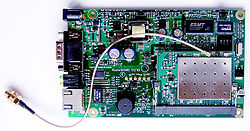
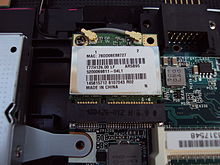
A wireless access point (WAP) connects a group of wireless devices to an adjacent wired LAN. An access point resembles a network hub, relaying data between connected wireless devices in addition to a (usually) single connected wired device, most often an Ethernet hub or switch, allowing wireless devices to communicate with other wired devices.
Wireless adapters allow devices to connect to a wireless network. These adapters connect to devices using various external or internal interconnects such as PCI, miniPCI, USB, ExpressCard, Cardbus and PC Card. As of 2010, most newer laptop computers come equipped with built in internal adapters.
Wireless routers integrate a Wireless Access Point, Ethernet switch, and internal router firmware application that provides IP routing, NAT, and DNS forwarding through an integrated WAN-interface. A wireless router allows wired and wireless Ethernet LAN devices to connect to a (usually) single WAN device such as a cable modem or a DSL modem. A wireless router allows all three devices, mainly the access point and router, to be configured through one central utility. This utility is usually an integrated web server that is accessible to wired and wireless LAN clients and often optionally to WAN clients. This utility may also be an application that is run on a computer, as is the case with as Apple's AirPort, which is managed with the AirPort Utility on Mac OS X and iOS.
Wireless network bridges connect a wired network to a wireless network. A bridge differs from an access point: an access point connects wireless devices to a wired network at the data-link layer. Two wireless bridges may be used to connect two wired networks over a wireless link, useful in situations where a wired connection may be unavailable, such as between two separate homes.
Wireless range-extenders or wireless repeaters can extend the range of an existing wireless network. Strategically placed range-extenders can elongate a signal area or allow for the signal area to reach around barriers such as those pertaining in L-shaped corridors. Wireless devices connected through repeaters will suffer from an increased latency for each hop, as well as from a reduction in the maximum data throughput that is available. In addition, the effect of additional users using a network employing wireless range-extenders is to consume the available bandwidth faster than would be the case where but a single user migrates around a network employing extenders. For this reason, wireless range-extenders work best in networks supporting very low traffic throughput requirements, such as for cases where but a single user with a Wi-Fi equipped tablet migrates around the combined extended and non-extended portions of the total connected network. Additionally, a wireless device connected to any of the repeaters in the chain will have a data throughput that is also limited by the "weakest link" existing in the chain between where the connection originates and where the connection ends. Networks employing wireless extenders are also more prone to degradation from interference from neighboring access points that border portions of the extended network and that happen to occupy the same channel as the extended network.
The security standard, Wi-Fi Protected Setup, allows embedded devices with limited graphical user interface to connect to the Internet with ease. Wi-Fi Protected Setup has 2 configurations: The Push Button configuration and the PIN configuration. These embedded devices are also called The Internet of Things and are low-power, battery-operated embedded systems. A number of Wi-Fi manufacturers design chips and modules for embedded Wi-Fi, such as GainSpan.
Distance records
Distance records (using non-standard devices) include 382 km (237 mi) in June 2007, held by Ermanno Pietrosemoli and EsLaRed of Venezuela, transferring about 3 MB of data between the mountain-tops of El Águila and Platillon. The Swedish Space Agency transferred data 420 km (260 mi), using 6 watt amplifiers to reach an overhead stratospheric balloon.
Embedded systems
Increasingly in the last few years (particularly as of 2007), embedded Wi-Fi modules have become available that incorporate a real-time operating system and provide a simple means of wirelessly enabling any device which has and communicates via a serial port. This allows the design of simple monitoring devices. An example is a portable ECG device monitoring a patient at home. This Wi-Fi-enabled device can communicate via the Internet.
These Wi-Fi modules are designed by OEMs so that implementers need only minimal Wi-Fi knowledge to provide Wi-Fi connectivity for their products.
Multiple access points
Increasing the number of Wi-Fi access points provides network redundancy, support for fast roaming and increased overall network-capacity by using more channels or by defining smaller cells. Except for the smallest implementations (such as home or small office networks), Wi-Fi implementations have moved toward "thin" access points, with more of the network intelligence housed in a centralized network appliance, relegating individual access points to the role of "dumb" transceivers. Outdoor applications may use mesh topologies.
Network security
The main issue with wireless network security is its simplified access to the network compared to traditional wired networks such as Ethernet, with wired networking one must either gain access to a building (physically connecting into the internal network) or break through an external firewall. To enable Wi-Fi, one merely needs to be within the wireless range of the Wi-Fi network. Most business networks protect sensitive data and systems by attempting to disallow external access. Enabling wireless connectivity reduces security if the network uses inadequate or no encryption.
An attacker who has gained access to a Wi-Fi network router can initiate a DNS spoofing attack against any other user of the network by forging a response before the queried DNS server has a chance to reply.
Securing methods
A common measure to deter unauthorized users involves hiding the access point's name by disabling the SSID broadcast. While effective against the casual user, it is ineffective as a security method because the SSID is broadcast in the clear in response to a client SSID query. Another method is to only allow computers with known MAC addresses to join the network, but determined eavesdroppers may be able to join the network by spoofing an authorized address.
Wired Equivalent Privacy (WEP) encryption was designed to protect against casual snooping but it is no longer considered secure. Tools such as AirSnort or Aircrack-ng can quickly recover WEP encryption keys. Because of WEP's weakness the Wi-Fi Alliance approved Wi-Fi Protected Access (WPA) which uses TKIP. WPA was specifically designed to work with older equipment usually through a firmware upgrade. Though more secure than WEP, WPA has known vulnerabilities.
The more secure WPA2 using Advanced Encryption Standard was introduced in 2004 and is supported by most new Wi-Fi devices. WPA2 is fully compatible with WPA.
A flaw in a feature added to Wi-Fi in 2007, called Wi-Fi Protected Setup, allows WPA and WPA2 security to be bypassed and effectively broken in many situations. The only remedy as of late 2011 is to turn off Wi-Fi Protected Setup, which is not always possible.
Piggybacking
Piggybacking refers to access to a wireless Internet connection by bringing one's own computer within the range of another's wireless connection, and using that service without the subscriber's explicit permission or knowledge.
During the early popular adoption of 802.11, providing open access points for anyone within range to use was encouraged to cultivate wireless community networks, particularly since people on average use only a fraction of their downstream bandwidth at any given time.
Recreational logging and mapping of other people's access points has become known as wardriving. Indeed, many access points are intentionally installed without security turned on so that they can be used as a free service. Providing access to one's Internet connection in this fashion may breach the Terms of Service or contract with the ISP. These activities do not result in sanctions in most jurisdictions; however, legislation and case law differ considerably across the world. A proposal to leave graffiti describing available services was called warchalking. A Florida court case determined that owner laziness was not to be a valid excuse.
Piggybacking often occurs unintentionally, since most access points are configured without encryption by default and operating systems can be configured to connect automatically to any available wireless network. A user who happens to start up a laptop in the vicinity of an access point may find the computer has joined the network without any visible indication. Moreover, a user intending to join one network may instead end up on another one if the latter has a stronger signal. In combination with automatic discovery of other network resources (see DHCP and Zeroconf) this could possibly lead wireless users to send sensitive data to the wrong middle-man when seeking a destination (see Man-in-the-middle attack). For example, a user could inadvertently use an unsecure network to log in to a website, thereby making the login credentials available to anyone listening, if the website uses an unsecure protocol such as HTTP.
Safety
The World Health Organization (WHO) says "there is no risk from low level, long-term exposure to wi-fi networks" and the United Kingdom's Health Protection Agency reports that exposure to Wi-Fi for a year results in the "same amount of radiation from a 20-minute mobile phone call."
A small percentage of Wi-Fi users have reported adverse health issues after repeat exposure and use of Wi-Fi, though there has been no publication of any effects being observable in double-blind studies. A review of studies involving 725 people that claimed electromagnetic hypersensitivity found no evidence for their claims.
One study claims, in preliminary results, that "laptops (Wi-Fi mode) on the lap near the testicles may result in decreased male fertility". Another small sample study (15 males and 15 females) found a decrease in the P300 event-related potential ( ERP) for male but not female subjects while engaging in a working memory oriented linguistic task during Wi-Fi exposure.

